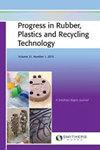Reactive compatibilization of biodegradable PLA/TPU blends via hybrid nanoparticle
IF 1.6
4区 材料科学
Q4 MATERIALS SCIENCE, COMPOSITES
Progress in Rubber Plastics and Recycling Technology
Pub Date : 2021-05-31
DOI:10.1177/14777606211019423
引用次数: 12
Abstract
In this study, the compatibilization effects of triglycidylisobutyl polyhedral oligomeric silsesquioxane (TEpPOSS) on biodegradable poly(lactic acid) (PLA)/thermoplastic polyurethane (TPU) blends were investigated. All blends were prepared via melt blending and PLA/TPU (80/20, 70/30, 50/50 wt%) ratio was selected as the experimental parameter. In order to predict the selective localization of TEpPOSS thermodynamically, wetting coefficient were determined by means of surface energy measurements. Morphological analyses were carried out by scanning electron microscopy (SEM) and transmission electron microscopy (TEM). Moreover, rheological, mechanical, thermomechanical and thermal properties of the blends were performed via rheometer, universal tensile tester, dynamic mechanic analyses and differential scanning calorimeter (DSC), respectively. Morphological test results revealed that TEpPOSSs were mostly located at the interfaces of the PLA and TPU phases. According to the rheological studies, the interfacial interactions between PLA and TPU were improved with the addition of TEpPOSS, which resulted from the potential reactions between epoxy-carboxylic acid and/or epoxy-hydroxyl functional groups. The addition of TEpPOSS enhanced the mechanical properties of PLA/TPU blends. DSC test results revealed a decrease in the glass transition temperatures of PLA in the presence of TEpPOSS, which was an another indication of improved compatibility between PLA and TPU.杂化纳米颗粒对可生物降解PLA/TPU共混物的反应增容
研究了三缩水甘油酯异丁基多面体低聚硅氧烷(TEpPOSS)对可生物降解聚乳酸(PLA)/热塑性聚氨酯(TPU)共混物的增容作用。所有共混物均采用熔融共混制备,实验参数选择PLA/TPU (80/ 20,70 / 30,50 /50 wt%)的比例。为了从热力学上预测TEpPOSS的选择性定位,采用表面能测量方法确定了润湿系数。通过扫描电镜(SEM)和透射电镜(TEM)进行形态学分析。通过流变仪、万能拉伸仪、动态力学分析和差示扫描量热仪(DSC)分别对共混物的流变学、力学、热力学和热性能进行了测试。形态学测试结果表明,TEpPOSSs主要分布在PLA相和TPU相的界面。流变学研究表明,由于环氧羧酸和/或环氧羟基官能团之间的潜在反应,TEpPOSS的加入改善了PLA与TPU之间的界面相互作用。TEpPOSS的加入提高了PLA/TPU共混物的力学性能。DSC测试结果显示,在TEpPOSS存在下,PLA的玻璃化转变温度降低,这是PLA和TPU之间相容性改善的另一个迹象。
本文章由计算机程序翻译,如有差异,请以英文原文为准。
求助全文
约1分钟内获得全文
求助全文
来源期刊

Progress in Rubber Plastics and Recycling Technology
MATERIALS SCIENCE, COMPOSITES-POLYMER SCIENCE
CiteScore
4.40
自引率
7.70%
发文量
18
审稿时长
>12 weeks
期刊介绍:
The journal aims to bridge the gap between research and development and the practical and commercial applications of polymers in a wide range of uses. Current developments and likely future trends are reviewed across key areas of the polymer industry, together with existing and potential opportunities for the innovative use of plastic and rubber products.
 求助内容:
求助内容: 应助结果提醒方式:
应助结果提醒方式:


